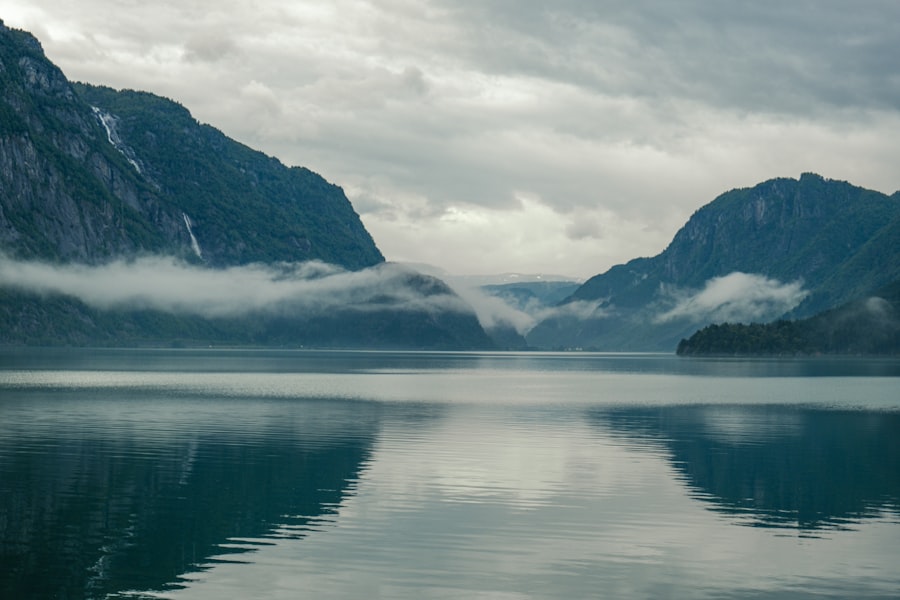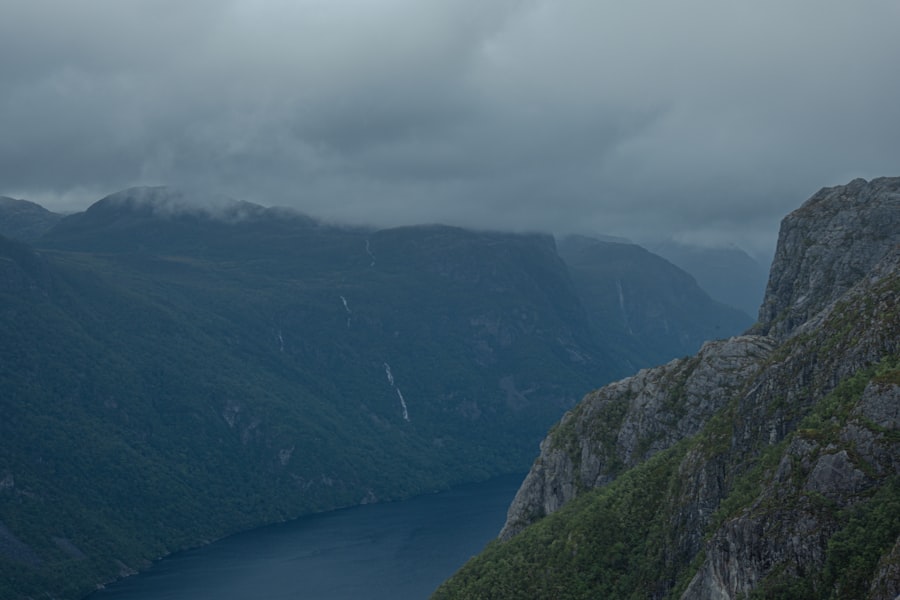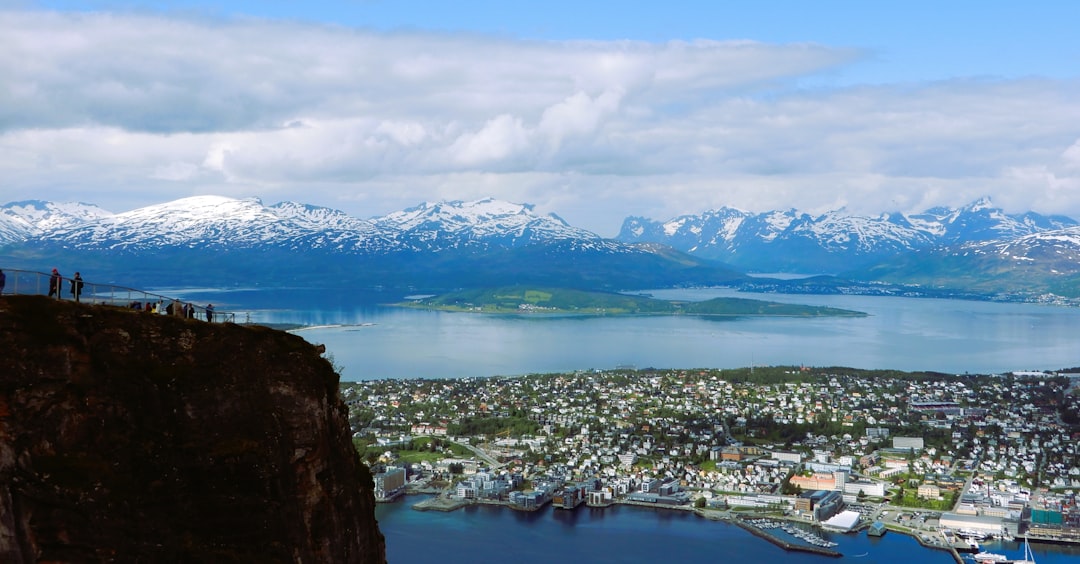The Northern Lights, or Aurora Borealis, are one of nature’s most spectacular phenomena, captivating the hearts and minds of those fortunate enough to witness them. This ethereal display of vibrant colours dancing across the night sky is caused by charged particles from the sun colliding with the Earth’s atmosphere. Norway, with its vast, unspoiled landscapes and minimal light pollution, offers some of the best vantage points for experiencing this celestial wonder.
The lights can appear in various hues, predominantly greens, but also reds, purples, and blues, creating a breathtaking spectacle that has inspired countless myths and legends throughout history. In Norway, the Northern Lights are not merely a visual treat; they are deeply woven into the cultural fabric of the country. For centuries, indigenous Sámi people have revered the lights, attributing them with spiritual significance.
They believed that the lights were the spirits of their ancestors or a manifestation of the souls of the departed. This rich cultural backdrop adds an extra layer of meaning to the experience of witnessing the Northern Lights, making it not just a visual feast but also a profound connection to the land and its history. Book Your 1-Hour Relocation Strategy Session
Summary
- The Northern Lights in Norway are a natural phenomenon caused by the interaction of solar particles with the Earth’s atmosphere, creating stunning displays of colourful lights in the sky.
- The best time to visit Norway for the Northern Lights is during the winter months, from late September to late March, when the nights are long and dark.
- Choosing the right location in Norway is crucial for Northern Lights viewing, with popular spots including Tromsø, Lofoten, and Finnmark due to their clear skies and minimal light pollution.
- When booking accommodation for Northern Lights viewing, consider staying in a remote location away from city lights, or opt for a hotel with a glass igloo or panoramic view for optimal viewing.
- Dressing for the cold weather is essential when viewing the Northern Lights, so be sure to pack warm layers, thermal clothing, insulated boots, and hand warmers to stay comfortable during the chilly nights.
- Capturing the Northern Lights on camera requires a tripod, long exposure settings, and a wide-angle lens to capture the full spectacle of the lights dancing across the sky.
- Joining a guided Northern Lights tour can enhance the experience with knowledgeable local guides who can take you to the best viewing spots and provide insight into the science and folklore of the lights.
- Alternative activities in Norway during the day include dog sledding, snowmobiling, ice fishing, and visiting traditional Sami villages to immerse yourself in the local culture and landscape.
- Local cuisine and dining options in Norway offer a chance to sample traditional dishes such as reindeer stew, smoked salmon, and cloudberries, as well as modern Nordic cuisine in local restaurants.
- Understanding the cultural significance of the Northern Lights to the indigenous Sami people and other local communities can deepen your appreciation for this natural wonder and the traditions surrounding it.
- Responsible travel and sustainability in Northern Lights tourism involves respecting the environment, supporting local businesses, and minimising your impact on the delicate Arctic ecosystem during your visit.
Best Time to Visit Norway for the Northern Lights
Timing is crucial when planning a trip to see the Northern Lights in Norway. The optimal period for viewing this natural wonder typically spans from late September to early April. During these months, the nights are long and dark, providing ample opportunity for the lights to make their appearance.
However, the peak season is often considered to be between December and March when conditions are most favourable. This timeframe not only offers longer nights but also clearer skies, which are essential for an unobstructed view of the auroras. It is also important to consider weather patterns when planning your visit.
While winter months provide the best chances for sightings, they can also bring unpredictable weather conditions. Cloud cover can obscure the lights, so it is wise to keep an eye on local forecasts and be flexible with your plans. Many visitors find that spending several days in Norway increases their chances of witnessing this breathtaking phenomenon, as it allows for adjustments based on weather conditions.
Choosing the Right Location in Norway

Norway boasts several prime locations for viewing the Northern Lights, each offering unique experiences and stunning backdrops. Tromsø, often referred to as the “Gateway to the Arctic,” is one of the most popular destinations for aurora hunters. Nestled between mountains and fjords, Tromsø provides a vibrant city atmosphere alongside easy access to remote areas where light pollution is minimal.
The city also hosts various tours and activities centred around the Northern Lights. Another excellent location is the Lofoten Islands, known for their dramatic landscapes and picturesque fishing villages. The islands offer a more tranquil setting for those seeking solitude while gazing at the auroras.
Additionally, Alta, often called the “City of the Northern Lights,” features a dedicated Northern Lights observatory and numerous outdoor activities that enhance the overall experience. Each location has its own charm and advantages, making it essential to consider what kind of experience you wish to have when choosing where to go.
Booking Accommodation for Northern Lights Viewing
When planning your trip to see the Northern Lights, selecting suitable accommodation is vital for maximising your experience. Many hotels and lodges in Northern Norway cater specifically to aurora enthusiasts, offering rooms with large windows or even glass-roofed cabins designed for optimal viewing. Staying in such accommodations allows you to enjoy the spectacle from the comfort of your room without having to venture out into the cold.
In addition to traditional hotels, there are also unique options such as igloos or traditional Sámi tents that provide an immersive experience. These accommodations often come equipped with amenities that enhance your stay, such as warm blankets and hot beverages. It is advisable to book well in advance during peak season, as these popular spots can fill up quickly.
By choosing accommodation wisely, you can ensure that you have a comfortable base from which to explore and enjoy the Northern Lights.
Dressing for the Cold Weather
Experiencing the Northern Lights often means braving cold temperatures, especially during winter months in Norway. Dressing appropriately is crucial not only for comfort but also for safety while you are out in the elements waiting for the lights to appear. Layering is key; start with a moisture-wicking base layer to keep sweat away from your skin, followed by insulating layers such as fleece or wool to retain warmth.
Outer layers should be windproof and waterproof to protect against harsh weather conditions. A good-quality winter coat, insulated gloves, warm hats, and thermal socks are essential items for any aurora chaser. Additionally, sturdy waterproof boots will keep your feet warm and dry while you traverse snowy landscapes.
By preparing adequately for the cold, you can fully immerse yourself in the experience without being hindered by discomfort.
Capturing the Northern Lights on Camera

For many visitors, capturing the beauty of the Northern Lights on camera is a top priority. However, photographing this elusive phenomenon requires some knowledge and preparation. A DSLR or mirrorless camera with manual settings is ideal for capturing long-exposure shots that reveal the intricate details of the auroras.
A sturdy tripod is essential to keep your camera steady during these long exposures. When setting up your shot, it’s important to experiment with different settings such as ISO, aperture, and shutter speed to find what works best for your specific conditions. A wide-angle lens can help capture more of the sky and foreground in your images.
Additionally, consider using a remote shutter release or timer function to avoid camera shake when taking photos. With patience and practice, you can create stunning images that will serve as lasting memories of your Northern Lights adventure.
Joining a Guided Northern Lights Tour
For those who prefer a more structured approach to witnessing the Northern Lights, joining a guided tour can be an excellent option. Many local operators offer tours led by knowledgeable guides who are well-versed in aurora chasing techniques and local weather patterns. These tours often include transportation to prime viewing locations away from city lights, increasing your chances of seeing the auroras.
Guided tours can vary in length and style; some may include additional activities such as dog sledding or snowmobiling under the lights, while others focus solely on aurora viewing. Participating in a tour not only enhances your chances of witnessing this natural wonder but also provides an opportunity to learn more about its science and cultural significance from experienced guides.
Alternative Activities in Norway during the Day
While waiting for nightfall to witness the Northern Lights, there are plenty of daytime activities to enjoy in Norway’s stunning landscapes. Winter sports enthusiasts can take advantage of skiing or snowboarding at various resorts throughout the country. The Lyngen Alps near Tromsø offer breathtaking views and excellent skiing opportunities for both beginners and experienced skiers alike.
For those seeking a more relaxed experience, consider exploring Norway’s charming towns and villages. The picturesque streets of Tromsø are lined with colourful wooden houses and quaint shops selling local crafts and souvenirs. Alternatively, you might embark on a scenic fjord cruise or take part in wildlife watching tours where you can spot reindeer or even whales during certain seasons.
These daytime adventures provide a well-rounded experience that complements your quest for the Northern Lights.
Local Cuisine and Dining Options
No trip to Norway would be complete without indulging in its rich culinary offerings. The country boasts a diverse range of traditional dishes that reflect its coastal geography and agricultural heritage. Fresh seafood is a highlight; dishes such as reindeer stew or grilled salmon are popular choices among locals and visitors alike.
Many restaurants in cities like Tromsø pride themselves on using locally sourced ingredients that showcase Norway’s natural bounty. For a truly authentic experience, consider dining at a traditional Norwegian restaurant where you can sample dishes like lutefisk or klippfisk (dried cod). Additionally, many establishments offer unique dining experiences such as dining under the stars or enjoying meals prepared over open fires in traditional Sámi tents.
Exploring local cuisine not only satisfies your palate but also deepens your understanding of Norwegian culture.
Understanding the Cultural Significance of the Northern Lights
The Northern Lights hold profound cultural significance in Norway and among indigenous peoples across the Arctic region. For many Sámi people, these lights are seen as a bridge between worlds—connecting them with their ancestors and nature itself. Folklore surrounding the auroras varies from tales of spirits dancing in the sky to beliefs that they represent messages from loved ones who have passed away.
This cultural context enriches any experience of witnessing the Northern Lights; it transforms what might be seen as merely a natural phenomenon into something deeply meaningful and spiritual. Engaging with local communities or participating in cultural events can provide further insight into how these beliefs shape people’s lives today and their relationship with nature.
Responsible Travel and Sustainability in Northern Lights Tourism
As interest in Northern Lights tourism continues to grow, it is essential to approach this experience with a sense of responsibility towards both nature and local communities. Sustainable travel practices help preserve Norway’s pristine environments while ensuring that future generations can enjoy these breathtaking sights as well. Opting for eco-friendly tours that prioritise minimal impact on natural habitats is one way travellers can contribute positively.
Additionally, supporting local businesses—such as family-run lodges or restaurants—helps sustain communities that rely on tourism while fostering authentic cultural exchanges. Being mindful of waste management practices during your travels also plays a crucial role in protecting Norway’s delicate ecosystems. By embracing responsible travel principles, visitors can enjoy their adventures while leaving a positive legacy behind.
In conclusion, experiencing the Northern Lights in Norway is an unforgettable journey filled with wonder and discovery. From understanding this natural phenomenon’s science and cultural significance to preparing adequately for cold weather and capturing its beauty on camera, every aspect contributes to an enriching adventure. To make this experience even more seamless and enjoyable, consider booking a One-Hour Strategy Session with the Norway Relocation Group.
Their expertise can guide you through planning your trip effectively—ensuring you maximise your chances of witnessing this awe-inspiring spectacle while immersing yourself fully in Norway’s rich culture and stunning landscapes.

